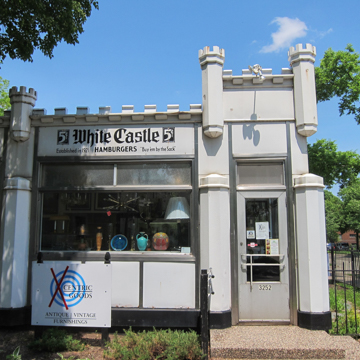You are here
White Castle Building No. 8
The White Castle Building No. 8 is a rare and intact design from the dawn of fast-food franchising. The prefabricated structure was manufactured by Porcelain Steel Buildings, a subsidiary of White Castle. Assembled in the company's Ohio plant, the building was shipped and completed on site in Minneapolis in 1936. Replacing a 1927 facility, it became the eighth White Castle branch in the region.
The small, 804-square-foot building features a porcelain enamel and steel exterior with crenellated towers and a parapet wall. The design was purportedly modeled after the Chicago Water Tower and represents one of the first successful applications of porcelain as a building material. The north, south, and east facades feature signage beneath the crenellated roofline. The words “White Castle” are written in a black, stylized, Old English font; the signage also includes smaller sans serif script advertisements: “5 Cent Hamburgers” and “Buy ‘Em by the Sack.”
White Castle has been credited as the nation's first fast-food chain restaurant. The corporation originated in 1916 in Wichita, Kansas. Walter Anderson, a cook, and Edgar Ingram, a local businessman, located their first restaurant in a remodeled streetcar; by 1921 the company had four buildings and a standardized design consisting of a small structure built of rusticated concrete block, with crenellations, a turret, and the painted words “White Castle hamburgers, 5 cents” below the roofline. By 1926, the chain opened locations in Kansas, Nebraska, Missouri, Michigan, Illinois, New Jersey, and Minneapolis-St. Paul. By 1931, the chain owned and operated 115 buildings. The company, White Castle System, Inc., moved its headquarters from Wichita to Columbus, Ohio, in 1933.
White Castle applied several innovations that prioritized efficiency, starting with its signature square hamburgers that better utilized grill space. The prefabricated, small buildings, with their standardized design, occupied small urban lots. In the 1920s, the company replaced the early rusticated concrete buildings with designs using porcelain enamel steel panels, establishing its own plant to manufacture the structure to be shipped and erected on site. The company also established its own beef processing plant, as well as one to manufacture paper employee caps. White Castle was so successful that, soon after its establishment, it had numerous imitators. The most well-known of the early competitors was White Tower, a chain founded in 1926 that blatantly replicated White Castle’s characteristic features, including the white exterior with a tower, open grill and counter with five stools, and small square burgers smothered with onions. As early as 1929, White Tower was sued by White Castle and forced to change its architecture.
White Castle Building No. 8 was originally located at 616 Washington Avenue Southeast. When its lease expired in 1950, the crenellated building was relocated to 329 Central Avenue Southeast, where it remained until its relocation to its current site in 1984. It was subsequently converted to offices. The characteristic stainless steel appliances, seating area, and counter were not retained. Fenestration consists of large windows and transoms, but the trademark stained glass was removed after the building was no longer part of the White Castle chain. The original doors were retained, as were the building’s two entrances: one on the west facade, and the main entrance on the south side beneath the crenellated corner tower. A three-foot-tall, wrought-iron fence is located along the Lyndale Avenue side of the building.
The current location is approximately two blocks south of Lake Street, a major east-west commercial thoroughfare that connects Minneapolis and St. Paul. The surrounding neighborhood along Lyndale Avenue, a major north-south thoroughfare, is mixed use, with scattered small-scale commercial enterprises and single-family, nineteeth- and early-twentieth-century houses along with two- or three-story brick twentieth-century apartment buildings and duplexes.
White Castle continues to operate throughout the country with approximately 420 buildings, despite the company's decision to not franchise. The chain’s standardized design changed through the years and is now a simplified form only suggestive of a castle. White Castle Building No. 8, despite being relocated three times, became a city of Minneapolis landmark in 1984.
References
Ahlgren, Carol. Interview with Philip Langdon, April 6, 2016.
Butko, Brian. “White Tower Takes on Pittsburgh.” Society for Commercial Archeology Journal 33, no. 2 (Fall 2015).
Langdon, Philip. Orange Roofs, Golden Arches: The Architecture of American Chain Restaurants. London: Michael Joseph, 1986.
Wilson, Kristin L. and Bean, Nella L., “White Castle Building Number 8,” Hennepin County, Minnesota. National Register of Historic Places Inventory Nomination Form, 1986. National Park Service, U.S. Department of the Interior, Washington D.C.
Writing Credits
If SAH Archipedia has been useful to you, please consider supporting it.
SAH Archipedia tells the story of the United States through its buildings, landscapes, and cities. This freely available resource empowers the public with authoritative knowledge that deepens their understanding and appreciation of the built environment. But the Society of Architectural Historians, which created SAH Archipedia with University of Virginia Press, needs your support to maintain the high-caliber research, writing, photography, cartography, editing, design, and programming that make SAH Archipedia a trusted online resource available to all who value the history of place, heritage tourism, and learning.

